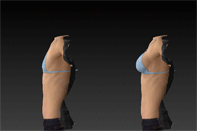(INFORMED CONSENT)
Information for Women considering Silicone Gel Breast Implants
Silicone implants have a silicone rubber shell that is filled with a fixed amount of silicone gel. Silicone implants come in smooth or textured shell surface and vary in shape, profile, volume, shell thickness, and number of shell lumens. Most silicone gel-filled implants are not adjustable which is one disadvantage compared to saline implants.
In 1999, a landmark report, undertaken by the Institute of Medicine (IOM) concluded that silicone implants do not cause major health problems such lupus or rheumatoid arthritis. And while no one can ignore the fact that silicone – and saline – breast implants may cause localized problems for some patients, numerous scientific studies over the years have shown that silicone gel-filled implants are both safe and effective for breast augmentation and reconstruction. In fact, silicone gel breast implants are widely used in 60 countries around the world including Europe, and now are available for use in the U.S. market.
In the past decade, a number of independent studies have examined whether silicone gel-filled breast implants are associated with connective tissue disease or cancer. The studies, including a report by the Institute of Medicine, have concluded there is no convincing evidence that breast implants are associated with either of these diseases. However, these issues will be addressed further in the post-approval studies conducted by Mentor Corporation and Allergan (manufacturers of FDA-approved silicone gel breast implants).
Information for Women considering Saline-Filled Breast Implants
Saline-filled breast implants (silicone envelopes containing salt water) were already in use in 1976 when the Food and Drug Administration (FDA) began regulating medical devices. The 1976 law allowed manufacturers to continue selling devices already on the market (“grandfathered” the devices), but also stated that, at some time in the future, manufacturers would need to provide the FDA with additional evidence on the safety of breast implants. Research on breast implants continues on an ongoing basis and the data will be provided to the FDA when requested. In May 2000, the saline implant companies received their pre-market approval (PMA), a rigorous evaluation the the implants, deeming saline implants safe and effective for their general use.
Dr. Adams is a nationally recognized and published author regarding breast implants and breast augmentation. He will be happy to answer any question you may have during the consultation.
Most Common Risks
1. Deflation: Breast implants do not last forever. A small percentage of implants can deflate (or rupture) in the first few months or years after being implanted; yet some are intact 10 or more years after the surgery. Predicting how long an implant will last, is not yet possible. However, researchers (including Dr. Adams) are studying deflation rates over time. Current data has indicated that current saline implants may last longer than silicone implants. Whether the implant breaks through normal wear or due to breast injury, it releases its saline (salt water) into the body. This usually happens quickly and surgery is then required to remove and, if desired, replace the deflated implant. Since salt water is naturally present in the body, the leaked saline will be safely absorbed by the body instead of being treated as foreign matter. Dr. Adams will quote a 1% per year deflation rate to his patients.
2. Making breast cancer harder to find: Breast implants may interfere with finding breast cancer during mammography by “hiding” suspicious-looking patches of tissue and making the mammogram more difficult to interpret. The implant may also make the x-ray harder to perform. Since the breast must be squeezed during mammography, every woman who has a breast implant must tell the technologist before the procedure. The technologist can use special techniques to minimize the possibility of deflation and obtain the best possible views of the tissue. However, more x-ray reviews are necessary when these special techniques are used, so women with breast implants will typically receive more radiation than women without implants. Still, the usefulness of a mammogram in finding cancer far outweighs the risk of the additional x-rays. There are also evolving techniques for breast screening (MRI) that is not affected by the presence of an implant.
3. Capsular contracture: In capsular contracture, the scar tissue (or capsule) that normally forms around an implant gradually tightens and squeezes the implant. Over several months or years, a breast may change shape, harden or become painful. Severe capsular contraction is not common, but it may require surgical removal of the implants. Capsular contracture is currently Dr. Adams’ primary research focus. He has developed several techniques to help prevent contracture, and contunues to develop other techniques that will hopefully mimimize this risk. The incidence of capsular contracture in saline breast augmentation is low, and Dr. Adams utilizes several special intra-operative and post-operative measure to help prevent this from occurring.
4. Loss of nipple sensation: Feeling in the nipple and breast can increase or decrease after implant surgery. Changes in feeling can be temporary or permanent and may affect sexual response or the ability to nurse a baby.
Most data suggests that loss of nipple sensation occurs in approximately 7% of the procedures. In some of these cases this may be only temporary but, permanent loss of nipple sensation is possible.
Other Known Risks
1. Calcium deposits in the tissue around the implant: Calcium deposits of this type are not harmful, but in mammograms they may resemble the calcium that is often a sign of breast cancer. Because of this similarity, a physician may occasionally decide to remove and examine a tiny amount of tissue (perform a biopsy) but this generally does not require removing the implant.
2. Additional surgeries:
Having a breast augmentation is like buying a new car, since it is naturally understood that a car will need to have maintenance performed at some point in the future. Dr. Adams instructs his patients that some maintenance may be required on your breast or implant in 10-15 years.
Patients should understand that additional surgery is likely to be needed at some point in the future to replace or remove implants that wear out. Also, problems such as deflation, capsular contracture, infection, shifting and calcium deposits can require surgery for removal. If or when you have an implant that requires surgical removal, you should discuss with Dr. Adams whether or not it should be replaced, since a replacement implant may require additional surgeries.
3. Infection: Infection can occur with any surgery. The probability of infection with implant surgery is not known, but you should ask Dr. Adams what his experience has been. Most infections resulting from surgery appear within a few days to weeks after the operation. However, infection is possible at any time after surgery. Dr. Adams does recommend that his patients with breast implants take antibiotics for 24 hours around dental procedures to help prevent infections. Infections with foreign bodies present (such as implants) are harder to treat than infections in normal body tissue. If an infection does not respond to antibiotics, the implant may be removed and later replaced with a new one, after the infection has been cured.
4. Hematoma: A hematoma is a collection of blood inside the body (in this case, around the implant or around the incision). Swelling, pain and bruising may result. The chance of getting a hematoma is not known, but you should ask Dr. Adams about his experience. A hematoma may occur soon after surgery, or at any time, if there is an injury to the breast. Small hematomas are absorbed by the body, but large ones may need to be drained surgically for proper healing. Surgical draining causes scarring, which is minimal in most cases.
5. Delayed wound healing: In rare instances, an implant may stretch the skin abnormally. This complication may require additional surgery.
6. Shifting of the implant: Sometimes an implant may shift from its initial placement, giving the breasts an unnatural look and requiring further surgery to correct the problem. An implant may become visible at the surface of the breast as a result of the device pushing through layers of skin. Or, an implant may shift so that it can be felt through the skin. (Placing the implant beneath the muscle may help to minimize the possibility of this problem.) Other problems with appearance could include incorrect implant size, visible scars, uneven appearance or wrinkling of the implant.
7. Autoimmune diseases: to date many studies have been done (primarily on silicone implants). The overall consensus is that the implants are not associated with autoimmune diseases.
Saline breast implants have never been implicated in causing autoimmune disease.










